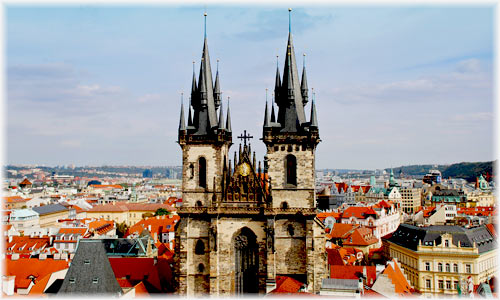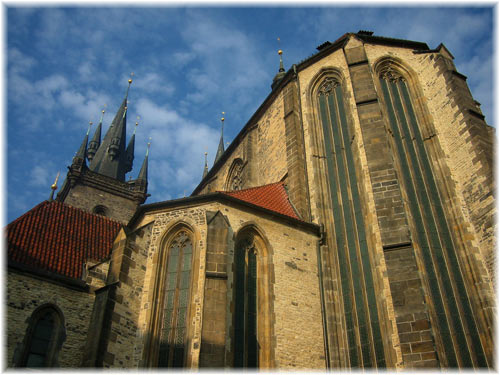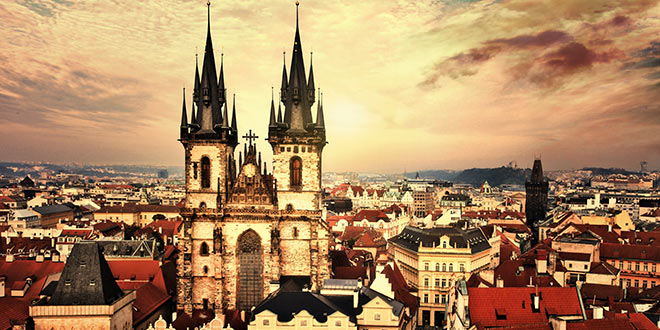Come to see this impressive Old Town parish church, especially at night. This Gothic church was built in 1365 on the site of an earlier Romanesque church. Its magnificent multiple steeples are 80m high and dominate the square. From the early 15th century until 1620, it was the main Hussite church in Prague. A beautiful entranceway decorated with scenes of Christ’s passion and a huge Rococo altar on the northern wall is its most striking feature. Right of the altar, there is a tomb of the Danish astronomer Tycho de Brahe who worked at the court of Emperor Rudolph II. Tyn church has a grand-sounding pipe organ and occasionally is a concert venue.

Location: Old Town Square, phone 222 322 801
Services: Wed-Sat at 6 pm, Sun 9.30 am and 9 pm (entrance for groups only by previous arrangement)
Admission: free
In Czech: Kostel Panny Marie před Týnem
History
The Church of Our Lady before Týn (Týnský chrám) is, without doubt, the most important ecclesiastical building on the right bank of the river Vltava. It earned its name thanks to an enclosed court, Tynsky dvur, also known as Ungelt. From the first half of the 13th century, this court served foreign merchants as a common lodging place or a custom-house. However, the Church of Our Lady itself is older. It was first mentioned along with a hospital in 1135. Its appearance in that period is not known to us yet. It became a parish church in the course of the 13th century and was enlarged radically at the turn of the 13th and the 14th centuries. The nave and two aisles each had a vaulted ceiling with a polygonal apse. There was a crypt and one western tower with a bell from 1310 onwards. This building was replaced by the present-day church. The only preserved part of the original church, St. Ludmila’s chapel, was pulled down one hundred years ago.
The present magnificent basilica was perhaps started in 1360. The choir and aisles were finished twenty years later. The master-builder of the 1st phase is believed to have been of Czech origin and was influenced by Silesian architecture and the Arras and Parler mason’s lodges, which worked on St. Vitus Cathedral. The 2nd phase was perhaps led by an artist and stonemasons of the Parler lodge. The west front was started at the beginning of the 15th century, and before the Hussite Wars, the nave was vaulted.

The main parish priest also used to be the university priest. Owing to the link with the university and thanks to preachers such as Conrad Waldhauser or Jan Milíe of Kromeriz, the Church of Our Lady before Týn became an important spiritual centre, and not only of the Old Town.
During the Hussite Wars and for many years afterwards, the construction of the church was delayed. In 1427 Jan of Rokycana became the priest and was elected the Prague Calixtine archbishop in 1435. The vicarage became “the lower consistory of the administration of the Sacrament in both ways”. Not until 1457 was the roof frame erected. The western gable was completed in 1463, while the construction of the northern tower lasted a further three years. The southern tower was under construction by the lodge of Matthias Rejsek in the years 1506-1511.
The Baroque style did not influence the exterior. Early Baroque black and gold altars and artificial marble panelling in the presbytery were donated by individual donators or guilds in the interior. In 1679 lightning caused a fire that burnt through the Gothic vaulted ceiling of the nave, which had to be replaced by a new, lower vault. Thus the windows of the presbytery were deprived of their pointed arches.
The most important priest was Jan Florián Hammerschmied, a historian and poet, writing in Czech and Latin, who worked there in 1710-1735. In 1784 the four towns of Prague were merged, and the Church of Our Lady before Týn became the first patron church of the city. In 1819 the northern tower was engulfed by a fire, again caused by lightning, during which a bell dating from 1585 melted. The reconstruction was completed in 1835.
In 1876-1895 a purist reconstruction was carried out. In due course, plaster was torn down incorrectly, and clay-slate rubble and sandstone supporting pillars were exposed. The beginning of the 20th century saw the restoration of the sacristy, and in 1906-1908 the northern portal was restored.
A new lengthy restoration took place in the years 1973-1995. Immediately afterwards, the restoration of the interior and furnishings began and is still underway.
The church was constructed as a nave with two aisles, each of which has its own polygonal apse. The walls were built of clay slate. Parts of the supporting pillars, the arches of the arcades and other details were carved in sandstone. The characteristic twin towers rise surrounded by a gallery with a balustrade and spires on the west side. The towers frame an intricate gable, in the middle of which pinnacles surround an early Baroque gilded sculpture of Our Lady in a halo.
The northern entrance portal is undoubtedly the most beautiful one. This work of the Parler lodge originated during the last twenty years of the 14th century. It is composed of a cathedral portal with an open porch and decorated with baldachins to protect the sculptures. The tympanum was panelled with reliefs, which are considered masterpieces of Czech medieval sculpture. They depict Passion scenes – the Flagellation, Coronation with the Crown of Thorns and the Crucifixion. It is ascribed to the Master who executed the bust of St. Cyril in the upper triforium of St. Vitus cathedral or to an artist from his circle. Parts of the relief were replaced by a copy in 1906-1908, the rest in 1998. The original was handed over to the National Gallery.
The interior of the church gives an impression of perfect balance. The vertical lines of the Gothic stand in harmony with decoration originating in all later styles. Large coats of arms decorate the early Baroque vault of the nave. The aisles are topped by ribbed vaults with a pear-shaped cross-section.
In the presbyteries of both aisles, the medieval sedilia attract special attention among the other preserved medieval details. They were made by stonemasons of the Parler lodge. The southern sedilia are older, dating from the 1370s. Their most important decoration is the brackets with royal busts, which are usually, and probably wrongly, taken to be the portraits of King John of Luxembourg and Elisabeth the Premyslid. The northern sedilia are also ascribed to the Master of the St. Cyril bust. The brackets bear the busts of King Wenceslas IV. and his wife Joan of Bavaria.
There are two unique monumental wood-carved works by the Master of the Týn Crucifixion. They form the Calvary in the west apse, which was originally situated on a beam in the triumphal arch in the nave. In a naturalistic way, it depicts Christ’s body, his wounds and his face full of suffering as well as the heart-broken faces of the Virgin Mary and St. John at the Cross. The National Gallery houses the original statue of St. John. The placement of the Seated Virgin Mary watching, with a hint of a smile, her infant son Jesus on her lap will be determined after the reconstruction. Both works date back to the time around 1410.
The pulpit is a work of the 15th century, while its roof and flight of stairs from 1847 were decorated by Josef Hellich, who executed the painted figures of church leaders, and by Eduard Veselý, who created the wood-carved figures of Czech patron saints.
Matìj Rejsek, a bachelor and a rector of the Týn School, is the author of an extraordinary piece of late Gothic work. He erected the stone polychrome baldachin on the second pillar of the northern aisle, which shades the tomb of archbishop Augustino Luciano of Mirandola, an Italian prelate who died in 1493. For ten years, he had been consecrating Czech Utraquist priests for a certain fee.
The aisle altar of John the Baptist is a rare work of the Danube wood-carving school from 1524-1525. An analysis of the style showed it to be the work of a master who used to sign his works IP. The wing altar, inlaid with reliefs, dates from the 17th century. The relief of the central piece depicts the Baptism of Christ in the Jordan, the predella bears the relief of the Nativity, and the extension depicts the Temptation of Christ framed by statues of St. George and St. Wenceslas. The uppermost part shows the Calvary. On the left-wing, there are the Annunciation and the Adoration of the Magi, and the Visitation of our Lady and the Beheading of St. John the Baptist are on the right-wing.
Prague’s second-biggest bell, Mary, hangs in the southern aisle and dates back to 1553. It was cast by a notable metal-founder Thomas Jaroš. Of all the Renaissance and early Baroque tombstones in the floor and walls of the church, the greatest attention is paid to the tombstone, dating from 1601, of the famous astronomer of the era of Rudolf II, Tycho Brahe, who was buried by the first inter-nave pillar on the right. He was joined by his wife three years later.
The altars of the Týn Church form a great gallery of Czech Baroque painting, sculpture and arts and crafts. The artist whose work is represented most is Karel Škréta, one of the outstanding Czech painters of the 17th century. His paintings can be admired on the high altar from 1649, built to give thanks for the liberation of Prague from the Swedes. Škréta’s works can also be seen on the altar of St. Adalbert from 1648 along with sculptures by Jan Jirí Bendl, on the altar of the Annunciation of the Blessed Virgin Mary from the period after 1660, again accompanied by Bendl’s sculptures, on the altar of St. Barbara from the same period and on the altar of the Holy Family from 1664. Among others, the altar of Christ’s Genealogy was decorated by Jan Jirí Heinsch sometime before 1690, the altar of St. Wenceslas shows the work of Anthony Stevens of Steinfels from 1664, Michael Halbax worked on the altar of St. Anne from 1706, and František Xaver Palko is represented by a painting on a Rococo altar of St. Expeditus from 1760. In the presbytery facing each other, there are two updated large canvases symbolizing the Visitation of Our Lady and the Adoration of the Shepherds by an Italian painter Girolamo Romanino, who died in 1556.
An extraordinary work of the medieval arts and crafts is the pewter baptismal font made by an Old Town smith, Master Wenceslas, in 1414. It has the shape of an upside-down bell resting on three lion paws which end in half-figures of bearded men. Shallow relief arcades decorate its coat with lancet arches and tracery surrounding the figures of the Apostles. Outside the arcades, there are the scenes of the Death of Our Lady and the Crucifixion. The case was completed by the metal-founder, Josef Goetzel, in 1846. The top carries a small figure of John the Baptist by Emanuel Max.
Two large late-Renaissance paintings hang facing each other in the presbytery. They show the Visitation of Our Lady and the Adoration of the Shepherds. They are ascribed to an Italian painter Girolamo Romanino, called il Romanino. This artist from Brescia, whose personal dates are not known exactly (born between 1484 – 1487, died after 1562), decorated many churches in neighbouring cities. His ceiling and altar paintings are distinguished by their multi-figural compositions and Titian colouring.


OK. I’ll ask. This etching, (?) has been in the family for God knows how long. Can you please tell me ANYTHING about it? My kids say it is lost to time. I think something this good has other pieces hanging around. thank you very much, Robert Hampton What a beautiful piece of art!
May I ask what was the name of this Church in 1887 if ever there were changes? The Philippine National Hero Jose Rizal visited Prague after his visit to Litomerice, formerly named Leitmeritz to see his friend Ferdinand Blumentritt. According Dr. Maximo Viola , Rizal’s travel companion, they visited the tomb of Copernicus, buried in Frombork Cathedral, but this is a mistake as Frombork in Poland. I could therefore argue that it was Tycho Brahe’s tomb, which they visited.
Thanks.
Consul Jed Dayang
Philippine Embassy
Prague
What I find truly perplexing, and for which I cannot find an answer anywhere, is how come two nice but architecturally incongruous buildings were erected directly in front of this church, thus severely obscuring its facade? To me, this is utterly, profoundly bizarre, and I can’t think of a major church or cathedral anywhere else in Europe with a facade that’s been blocked in this manner. Can anyone explain why? I would really love to know, as no descriptions of this church that I’ve found offer any kind of explanation (which is also quite puzzling).
Jeff, I had visited Prague a few years ago and our guide explained that to me: During the Hussite wars, the church was occupied by Hussites. Tyn Church was founded in 1385, a tumultuous period when Hussites were being slaughtered by the ruling Roman Catholics. Indeed, in time Catholic Jesuits took over the church, recasting the bell and replacing the Hussites symbolic chalice with a large figure of Mary nailed between the towers. Afterwards, fearing that this church could be occupied or destryoed during the wars, it was decided to built all those houses surrounding it to “hide” this church and thus preserve it in future.
The people entrance for Tyn Church is is still through one passage in the front house. I saw it.
That’s all I know, sorry.
Regards – Isabel
Thank you – very interesting. The relationship between the Hussites and the Virgin Mary seems – to put it mildly – rather complex.
I also find it very strange – almost like the church would be a relict of a long-firgotten religion, unused for ages and built-up with other buildings.
This is an extraordinarily well-written article, which seems to have crystallized the ‘art history’ of this impressive edifice, over quite a number of centuries. Fascinating -but I’m going to have to give it another, more thorough reading, because, based on something I read before this article, I had the impression this was/is a Protestant church, and that part -what you might call its religious affiliation/Provenance- is still sort of unclear, since so much of the art and architectural traditions sound to be Roman Catholic. I’ll look this up on my own, most likely, but the ambiguity seemed a curiosity, given the unusual degree of clarity concerning all the rest. Thanks for this article, though. It really demonstrates a very special talent.